Conceptual Model of Digitization of the Municipal Wastewater Disposal Systems
Abstract
1. Introduction
- Control of technological processes at established sampling points of wastewater and sludge, characteristics of existing control devices for treatment facilities;
- Technological analysis of equipment operation according to production performance indicators;
- Regulation of resource consumption and cleaning efficiency in accordance with regulatory established criteria and indicators.
- −
- Complexity of adaptive management of WTPs;
- −
- Lack of system solutions for operational measurements and forecasts of wastewater quality and volume indicators directly in the wastewater disposal networks before they enter the WTP;
- −
- Lack of operational control over the state of the wastewater disposal network and untimely maintenance and repair;
- −
- Lack of means for impacting (on-site) intelligent monitoring of key wastewater polluting facilities—with justification for their excess of regulatory requirements for wastewater disposal and a logical forecast of the danger of the impact of their waste on the sewerage network and WTP;
- −
- Unrepresentative (incorrect) formation of technical specifications for the construction (reconstruction, modernization) of wastewater disposal networks, including WTPs.
- −
- SCADA only solves the tasks of technological dispatching without forecasting the development of risks and resource efficiency—there is no indirect assessment of the technological situation;
- −
- Lack of solutions to related problems: maintenance and repair, resource and personnel management, analysis of economic efficiency; the user, in many cases, does not see the production value from the created and filled databases that are supported within the framework of SCADA functioning;
- −
- There is no operational communication between the technical system and engineering and technological specialists (as a rule, only through a mobile SCADA operator—when the system considers that the situation is an emergency).
2. Materials and Methods
- Monitoring water disposal process modes and formalizing the presentation of the entire process, its sections, and their complex interrelations in a form convenient for analysis and that can be understood by specialists.
- Operational support for decision-making in wastewater management, with the ability to increase the efficiency (environmental and resource) of the technological process and select the optimal method for its intensification—based on adaptive algorithms, in accordance with the requirements for maximum permissible concentrations stipulated by law, achieving maximum efficiency of equipment (air blower units of treatment facilities, etc.).
- Monitoring the efficiency (environmental and resource) of technological processes of treatment facilities, increasing their reliability and efficiency of process control (response to external disturbances: changes in loads, salvo influxes of pollutants (including toxicants), fluctuations in biogenic element indicators, etc.) in order to determine and predict its critical points.
- Ensuring the economic efficiency of operation, maintenance and repair of technological units of wastewater disposal systems at all stages of their life cycles (justification for modernization and reconstruction) while ensuring environmental safety of the environment.
- «Classic hardware…»: collection of information on the parameters of water disposal processes (primarily from measuring instruments), their primary analysis and processing, transfer of pre-processed information to the decision support system (DSS) and display of graphical trends for process personnel, and process control (including dispatching).
- DSS: receipt of pre-processed information from «Classic hardware…»; generation of recommendations for making process decisions by process personnel based on data from «Classic hardware…» and information from the knowledge base; and generation of information for transfer to the knowledge base.
- Knowledge base: storing information and knowledge of technological processes, and developing ontological solutions for the DSS.
- Technological personnel: making and transferring management decisions to “Classic hardware…” based on the DSS recommendations and visual trends from “Classic hardware…”.
- The disturbing effects of wastewater quality indicators on municipal wastewater treatment plants are the values of wastewater quality indicators that cause any impacts not provided for by the technological documents of wastewater disposal processes and lead to a violation of the technological regime of wastewater treatment at wastewater treatment plants;
- The control by disturbance of wastewater disposal parameters is the measurement of quality indicators of subscribers’ wastewater that cause disturbances, analysis of their deviations from technologically safe values for treatment facilities, and prediction of their impact on the efficiency of wastewater treatment at the municipal wastewater disposal system.
3. Results
- −
- Wastewater at the WTP inlet + model protein solution;
- −
- Wastewater at the WTP inlet + model fat solution;
- −
- Wastewater at the WTP inlet + model protein-fat solution.
4. Discussion
- The quality indicators of municipal wastewater under the influence of factors occurring in the sewerage network without disturbing influences in the form of introduced additional pollutants are quite stable and predictable: fluctuations in values occur only for “pH” and “ORP”, which is caused by the bio-chemical multifactorial formation of their values and specifics of instrumental measurements;
- As a result of the complex disturbing effects of acids, alkalis, temperature, organic pollutants of protein and fatty natures in aerobic conditions, significant amplitude fluctuations in the parameters of aqueous solutions from the value of their mathematical expectation take place: for ammonium nitrogen—about 10%–100%, for nitrites—about 20%–50%, for nitrates–about 10%–40%;
- As a result of the complex disturbing effects of temperature and organic pollutants of protein and fatty natures under anaerobic conditions (6 h of stirring), significant amplitude fluctuations in the parameters of aqueous solutions occur from the value of their mathematical expectation only for ammonium nitrogen: about 20%–100%;
- Disturbing influences in the form of pollutants in discharged wastewater from individual users (usually industrial enterprises), under certain conditions, can potentially form indicators of the quality of wastewater at their inlet that are unacceptable for the municipal WDS—which must be preventively counteracted not only at the stage of such pollutants entering the sewerage network but also by preventing the creation of conditions for the formation of secondary pollutants in pipelines, sewage pumping stations and other sewerage technological units.
- −
- Implement operational control over wastewater disposal and treatment (adapting software to classical wastewater treatment process schemes and process schemes using modern technologies for removing biogenic elements);
- −
- Ensure optimization and increased efficiency (environmental and resource) of the water disposal and water treatment process and promptly apply optimal methods for its intensification;
- −
- Increase the validity and efficiency of management decision-making (according to preliminary estimates);
- −
- Reduce the time for making management decisions by an order of magnitude;
- −
- Virtually eliminate errors in information support;
- −
- Significantly optimize data search and extraction;
- −
- Reduce the time for planning operations several times;
- −
- Improve the quality and effectiveness of information interactions between stakeholders by increasing the degree of integration of information flows and resources, including communications with design organizations;
- −
- Achieve completeness, relevance and reliability of information on drainage and treatment processes;
- −
- Ensure comprehensiveness and a synergistic effect in solving problems of information and analytical support for water disposal;
- −
- Improve the efficiency of data collection, comparison, analysis and reporting, as well as improve the implementation of regulatory indicators;
- −
- Reduce the risks of man-made emergencies;
- −
- Systematically improve the qualifications and retrain specialists of enterprises in the field of digital technologies;
- −
- Form and scale to other objects of the knowledge base and digital models (digital twins);
- −
- Improve the economic efficiency of operation, maintenance and repair (validity of modernization and reconstruction) of process units at all stages of their life cycles;
- −
- Optimize (significantly reduce the cost) the architecture of automation hardware, including the minimization of the use of measuring systems;
- −
- Create a single end-to-end unified software product for designers and operators of biological treatment facilities (managers, economists, technologists, engineers, operators) with the ability to form local centers for operational management of the life cycles of wastewater disposal systems.
- −
- Classic hardware: Internet of Things, digital twins, and artificial intelligence.
- −
- DSS: artificial intelligence, digital twins, machine learning, and big data.
- −
- Knowledge base: artificial intelligence, machine learning, and big data.
- −
- Technological personnel: Artificial Intelligence (AI).
- −
- Design and development of the mathematical and technological core.
- −
- Development and experimental processing of applied digital services using the created mathematical and technological core.
- −
- Implementation, adjustment and trial operation. Transition to regular operation.
5. Conclusions
Author Contributions
Funding
Data Availability Statement
Acknowledgments
Conflicts of Interest
References
- Bassin, J.; Castro, F.; Valério, R.; Santiago, E.; Bassin, I. Chapter 16—The impact of wastewater treatment plants on global climate change. In Water Conservation in the Era of Global Climate Change; Elsevier: Amsterdam, The Netherlands, 2021; p. 410. [Google Scholar] [CrossRef]
- Obaideen, K.; Shehata, N.; Sayed, E.; Abdelkareem, M.; Mahmoud, M.; Olabi, A. The role of wastewater treatment in achieving sustainable development goals (SDGs) and sustainability guideline. Energy Nexus 2022, 7, 100112. [Google Scholar] [CrossRef]
- Gallego-Schmid, A.; Tarpani, R.R.Z. Life cycle assessment of wastewater treatment in developing countries: A review. Water Res. 2019, 153, 63–79. [Google Scholar] [CrossRef] [PubMed]
- Fatimah, Y.A.; Govindan, K.; Murniningsih, R.; Setiawan, A. Industry 4.0 based sustainable circular economy approach for smart waste management system to achieve sustainable development goals: A case study of Indonesia. J. Clean. Prod. 2020, 269, 122263. [Google Scholar] [CrossRef]
- Hasan, H.A.; Muhammad, M.H. A review of biological drinking water treatment technologies for contaminants removal from polluted water resources. J. Water Process Eng. 2020, 33, 101035. [Google Scholar] [CrossRef]
- Kehrein, P.; Van Loosdrecht, M.; Osseweijer, P.; Garfí, M.; Dewulf, J.; Posada, J. A critical review of resource recovery from municipal wastewater treatment plants–market supply potentials, technologies and bottlenecks. Environ. Sci. Water Res. Technol. 2020, 6, 877–910. [Google Scholar] [CrossRef]
- Hughes, J.; Cowper-Heays, K.; Olesson, E.; Bell, R.; Stroombergen, A. Impacts and implications of climate change on wastewater systems: A New Zealand perspective. Clim. Risk Manag. 2021, 31, 100262. [Google Scholar] [CrossRef]
- Ranieri, E.; D’Onghia, G.; Lopopolo, L.; Gikas, P.; Ranieri, F.; Gika, E.; Ranieri, A. Influence of climate change on wastewater treatment plants performances and energy costs in Apulia, south Italy. Chemosphere 2024, 350, 141087. [Google Scholar] [CrossRef]
- Adedeji, K.B.; Ponnle, A.A.; Abu-Mahfouz, A.M.; Kurien, A.M. Towards digitalization of water supply systems for sustainable smart city development—Water 4.0. Appl. Sci. 2022, 12, 9174. [Google Scholar] [CrossRef]
- Banerjee, C.; Bhaduri, A.; Saraswat, C. Digitalization in Urban Water Governance: Case Study of Bengaluru and Singapore. Front. Environ. Sci. 2022, 10, 816824. [Google Scholar] [CrossRef]
- Boyle, C.; Ryan, G.; Bhandari, P.; Law, K.M.; Gong, J.; Creighton, D. Digital transformation in water organizations. J. Water Resour. Plan. Manag. 2022, 148, 03122001. [Google Scholar] [CrossRef]
- Guandalini, I. Sustainability through digital transformation: A systematic literature review for research guidance. J. Bus. Res. 2022, 148, 456–471. [Google Scholar] [CrossRef]
- Alrbai, M.; Al-Dahidi, S.; Al-Ghussain, L.; Alahmer, A.; Hayajneh, H. Minimizing grid energy consumption in wastewater treatment plants: Towards green energy solutions for water sustainability in Jordan. Sci. Total Environ. 2024, 926, 172139. [Google Scholar] [CrossRef] [PubMed]
- Al-Dahidi, S.; Alrbai, M.; Al-Ghussain, L.; Alahmer, A. Maximizing energy efficiency in wastewater treatment plants: A data-driven approach for waste heat recovery and an economic analysis using Organic Rankine Cycle and thermal energy storage. Appl. Energy 2024, 362, 123008. [Google Scholar] [CrossRef]
- Aghabalaei, V.; Nayeb, H.; Mardani, S.; Tabeshnia, M.; Baghdadi, M. Minimizing greenhouse gases emissions and energy consumption from wastewater treatment plants via rational design and engineering strategies: A case study in Mashhad, Iran. Energy Rep. 2023, 9, 2310–2320. [Google Scholar] [CrossRef]
- Masłoń, A.; Czarnota, J.; Szaja, A.; Szulżyk-Cieplak, J.; Łagód, G. The enhancement of energy efficiency in a wastewater treatment plant through sustainable biogas use: Case study from Poland. Energies 2020, 13, 6056. [Google Scholar] [CrossRef]
- Hu, W.; Tian, J.; Li, X.; Chen, L. Wastewater treatment system optimization with an industrial symbiosis model: A case study of a Chinese eco-industrial park. J. Ind. Ecol. 2020, 24, 1338–1351. [Google Scholar] [CrossRef]
- Zhao, L.; Dai, T.; Qiao, Z.; Sun, P.; Hao, J.; Yang, Y. Application of artificial intelligence to wastewater treatment: A bibliometric analysis and systematic review of technology, economy, management, and wastewater reuse. Process Saf. Environ. Prot. 2020, 133, 169–182. [Google Scholar] [CrossRef]
- Li, L.; Rong, S.; Wang, R.; Yu, S. Recent advances in artificial intelligence and machine learning for nonlinear relationship analysis and process control in drinking water treatment: A review. Chem. Eng. J. 2021, 405, 126673. [Google Scholar] [CrossRef]
- Wang, D.; Thunéll, S.; Lindberg, U.; Jiang, L.; Trygg, J.; Tysklind, M.; Souihi, N. A machine learning framework to improve effluent quality control in wastewater treatment plants. Sci. Total Environ. 2021, 784, 147138. [Google Scholar] [CrossRef]
- Schneider, M.Y.; Quaghebeur, W.; Borzooei, S.; Froemelt, A.; Li, F.; Saagi, R.; Torfs, E. Hybrid modelling of water resource recovery facilities: Status and opportunities. Water Sci. Technol. 2022, 85, 2503–2524. [Google Scholar] [CrossRef]
- Alvi, M.; Batstone, D.; Mbamba, C.K.; Keymer, P.; French, T.; Ward, A.; Cardell-Oliver, R. Deep learning in wastewater treatment: A critical review. Water Res. 2023, 245, 120518. [Google Scholar] [CrossRef] [PubMed]
- Zhao, J.; Shang, C.; Yin, R. Developing a hybrid model for predicting the reaction kinetics between chlorine and micropollutants in water. Water Res. 2023, 247, 120794. [Google Scholar] [CrossRef] [PubMed]
- Zhu, M.; Wang, J.; Yang, X.; Zhang, Y.; Zhang, L.; Ren, H.; Ye, L. A review of the application of machine learning in water quality evaluation. Eco-Environ. Health 2022, 1, 107–116. [Google Scholar] [CrossRef] [PubMed]
- Alekseevsky, D.; Chernysh, Y.; Shtepa, V.; Chubur, V.; Stejskalová, L.; Balintova, M.; Fukui, M.; Roubík, H. Enhancing Ecological Efficiency in Biological Wastewater Treatment: A Case Study on Quality Control Information System. Water 2023, 15, 3744. [Google Scholar] [CrossRef]
- Chen, Y.; Song, L.; Liu, Y.; Yang, L.; Li, D. A review of the artificial neural network models for water quality prediction. Appl. Sci. 2020, 10, 5776. [Google Scholar] [CrossRef]
- Lowe, M.; Qin, R.; Mao, X. A review on machine learning, artificial intelligence, and smart technology in water treatment and monitoring. Water 2022, 14, 1384. [Google Scholar] [CrossRef]


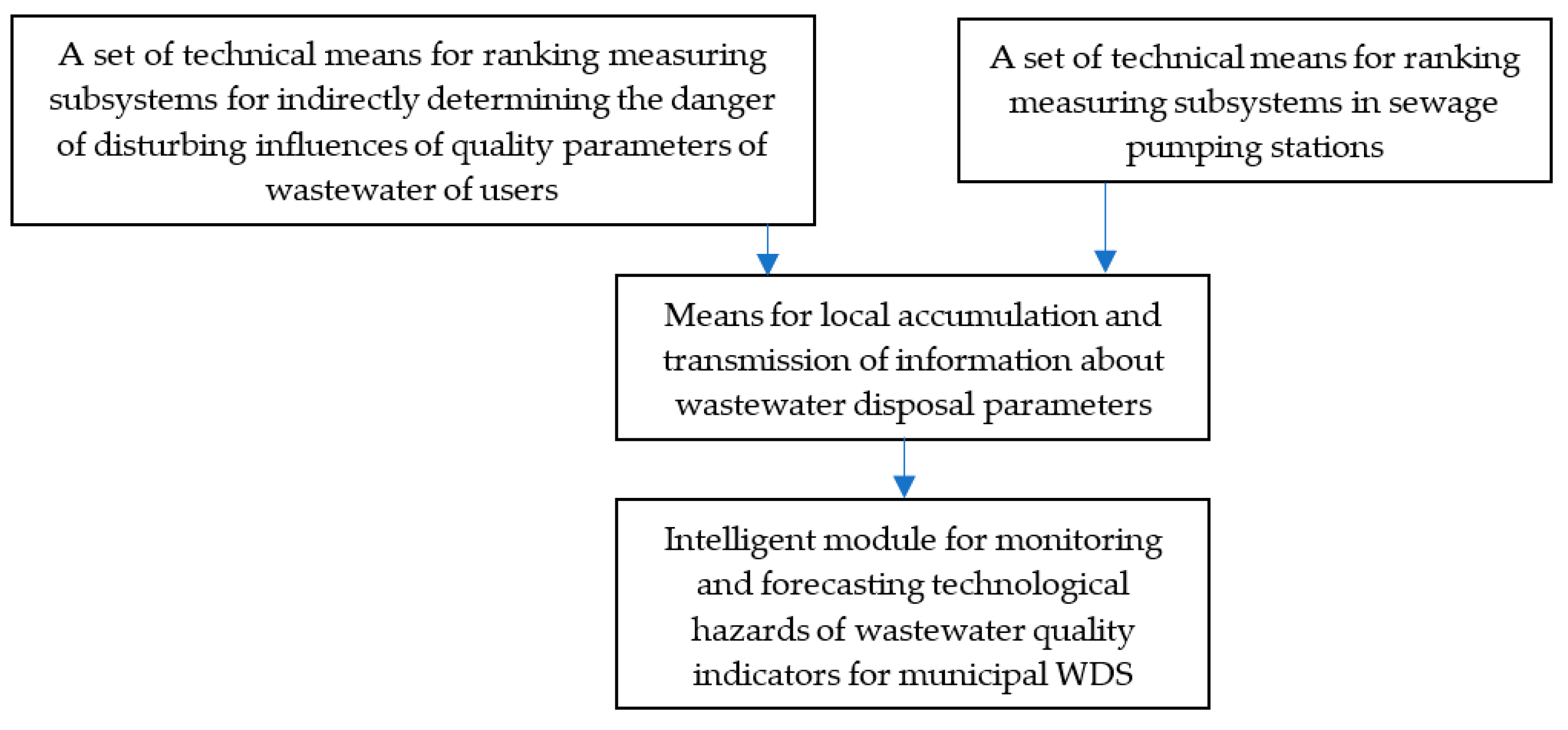

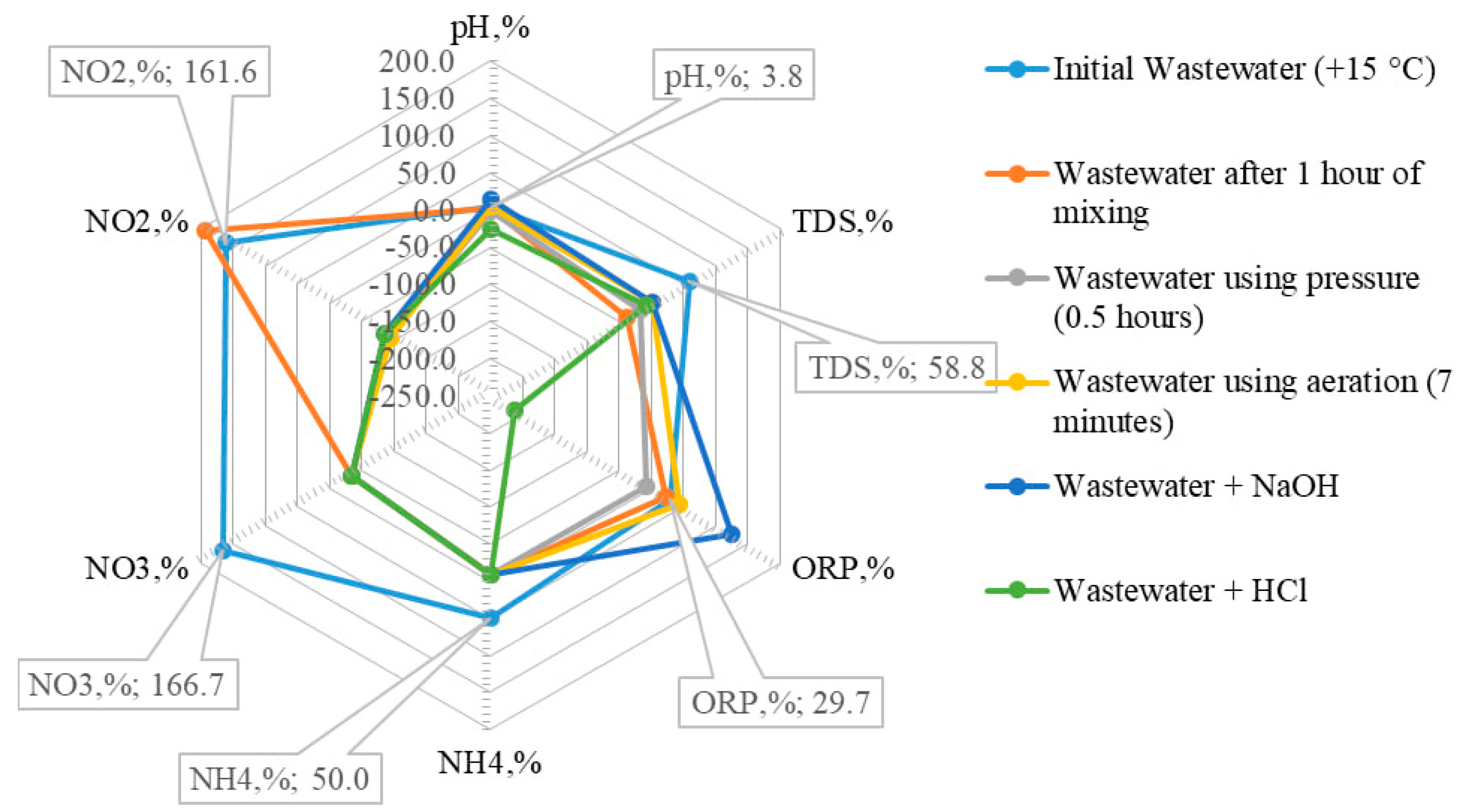
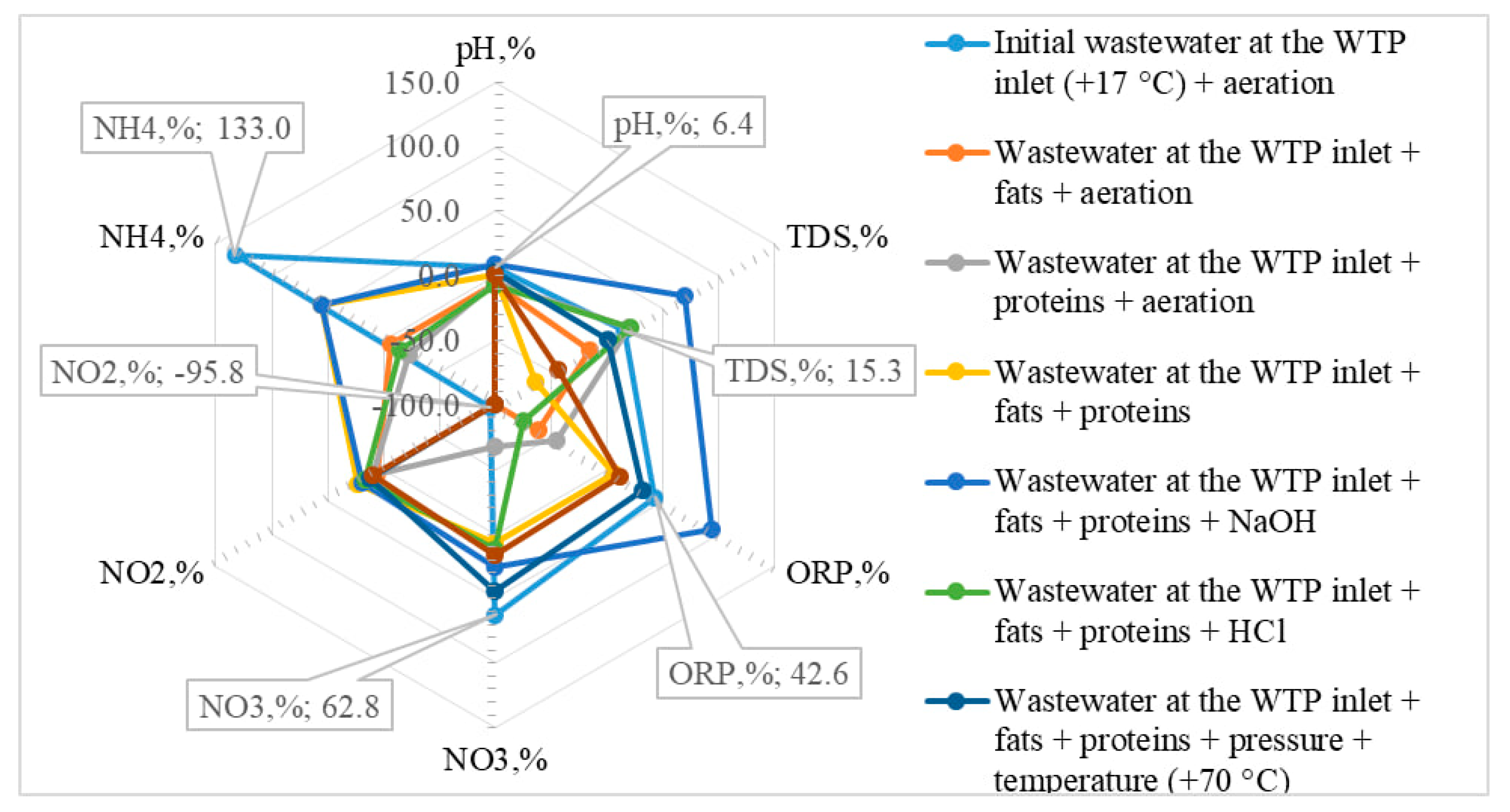
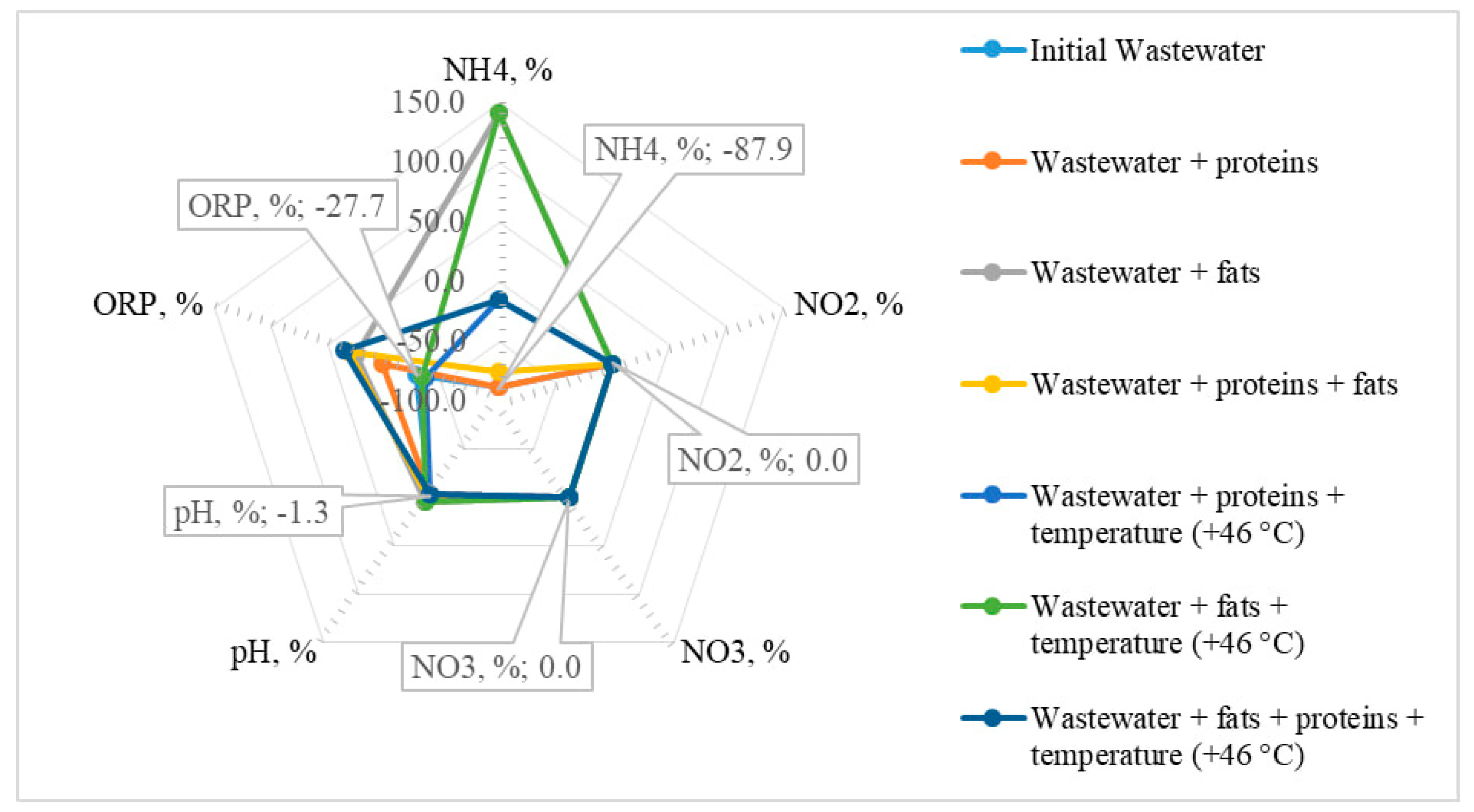
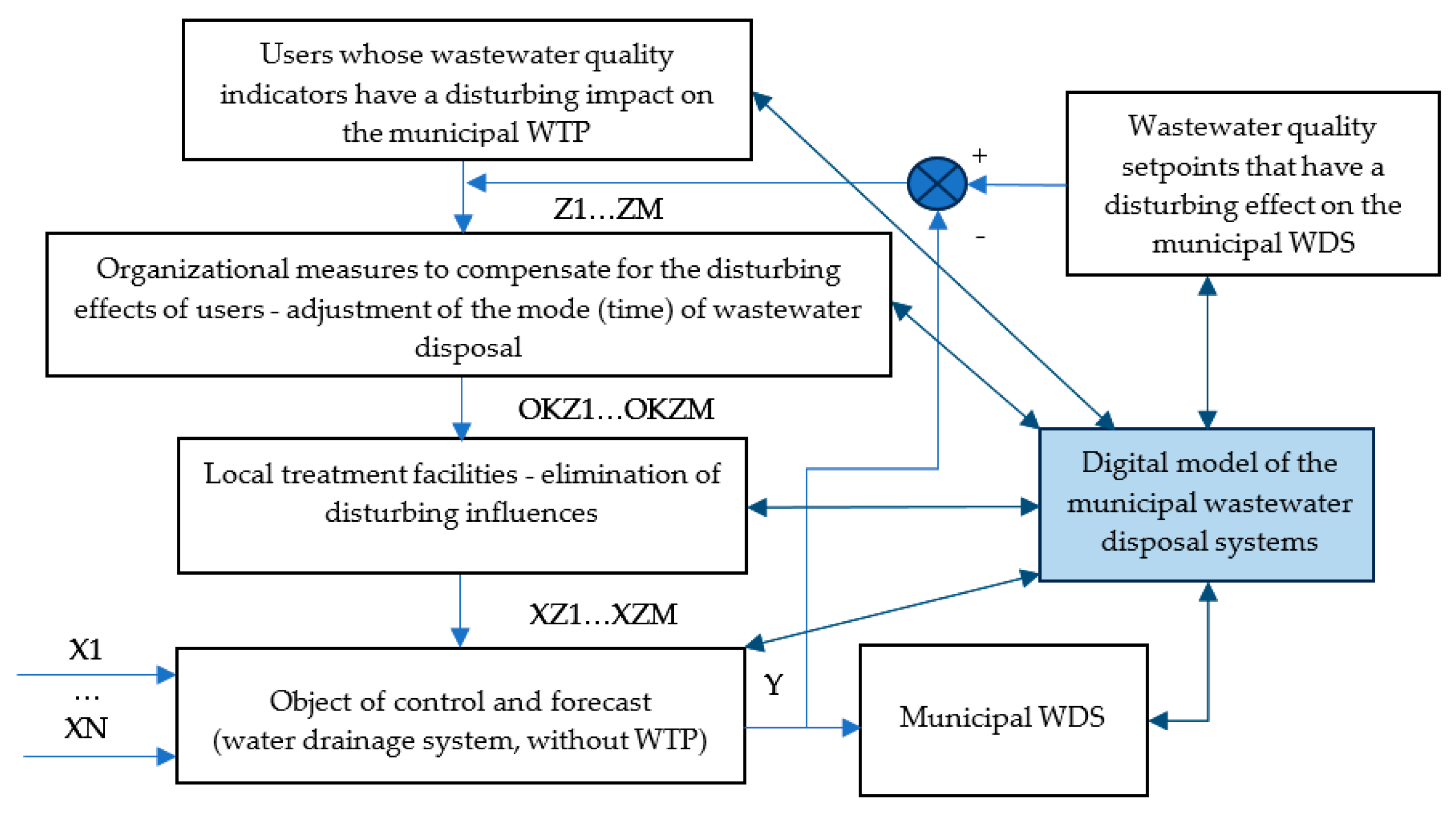
| Test | pH | TDS, ppm | ORP, mV | NH4, mg/L | NO3, mg/L | NO2, mg/L |
|---|---|---|---|---|---|---|
| Initial Wastewater (+15 °C) | 8.24 | 761.00 | −70.40 | 2.50 | 50.00 | 33.00 |
| Waste water after 1 h of mixing | 8.13 | 302.00 | −66.50 | 1.50 | 12.50 | 37.00 |
| Wastewater using pressure (0.5 h) | 787 | 395.00 | −50.70 | 1.50 | 12.50 | 0.90 |
| Wastewater using aeration (7 min) | 8.34 | 491.00 | −77.40 | 1.50 | 12.50 | 0.80 |
| Wastewater + NaOH | 9.10 | 487.00 | −122.00 | 1.50 | 12.50 | 2.00 |
| Wastewater + HCl | 5.95 | 440.00 | 61.40 | 1.50 | 12.50 | 2.00 |
| Test | pH | TDS, ppm | ORP, mV | NO3, mg/L | NO2, mg/L | NH4, mg/L |
|---|---|---|---|---|---|---|
| Initial wastewater at the WTP inlet (+17 °C) + aeration | 8.29 | 589.00 | −64.60 | 35.00 | 1.20 | 0.30 |
| Wastewater at the WTP inlet + fats + aeration | 7.27 | 430.00 | −17.20 | 0.00 | 30.00 | 0.12 |
| Wastewater at the WTP inlet + proteins + aeration | 7.42 | 610.00 | −24.50 | 7.00 | 31.00 | 0.10 |
| Wastewater at the WTP inlet + fats + proteins | 7.82 | 182.00 | −47.70 | 23.00 | 35.00 | 0.20 |
| Wastewater at the WTP inlet + fats + proteins + NaOH | 8.48 | 863.00 | −87.30 | 27.00 | 34.00 | 0.20 |
| Wastewater at the WTP inlet + fats + proteins + HCl | 7.20 | 616.00 | −11.10 | 24.00 | 33.00 | 0.11 |
| Wastewater at the WTP inlet + fats + proteins + pressure + temperature (+70 °C) | 8.02 | 515.00 | −59.60 | 31.00 | 32.00 | 0.00 |
| Wastewater at the WTP inlet + fats + proteins + temperature (+70 °C) | 7.83 | 283.00 | −50.30 | 25.00 | 31.00 | 0.00 |
| Test | NH4 | NO2 | NO3 | pH | ORP |
|---|---|---|---|---|---|
| Initial Wastewater | 0.1 | 0.1 | 0 | 6.6 | −108 |
| Wastewater + proteins | 0.1 | 0.1 | 0 | 6.5 | −152 |
| Wastewater + fats | 2.0 | 0.1 | 0 | 7.0 | −187 |
| Wastewater + proteins + fats | 0.2 | 0.1 | 0 | 6.7 | −198 |
| Wastewater + proteins + temperature (+46 °C) | 0.7 | 0.1 | 0 | 6.5 | −96 |
| Wastewater + fats + temperature (+46 °C) | 2.0 | 0.1 | 0 | 7.0 | −101 |
| Wastewater + fats + proteins + temperature (+46 °C) | 0.7 | 0.1 | 0 | 6.5 | −203 |
Disclaimer/Publisher’s Note: The statements, opinions and data contained in all publications are solely those of the individual author(s) and contributor(s) and not of MDPI and/or the editor(s). MDPI and/or the editor(s) disclaim responsibility for any injury to people or property resulting from any ideas, methods, instructions or products referred to in the content. |
© 2024 by the authors. Licensee MDPI, Basel, Switzerland. This article is an open access article distributed under the terms and conditions of the Creative Commons Attribution (CC BY) license (https://creativecommons.org/licenses/by/4.0/).
Share and Cite
Shtepa, V.; Junakova, N.; Zaiets, N.; Lutska, N.; Chernysh, Y.; Balintova, M. Conceptual Model of Digitization of the Municipal Wastewater Disposal Systems. Water 2024, 16, 3483. https://doi.org/10.3390/w16233483
Shtepa V, Junakova N, Zaiets N, Lutska N, Chernysh Y, Balintova M. Conceptual Model of Digitization of the Municipal Wastewater Disposal Systems. Water. 2024; 16(23):3483. https://doi.org/10.3390/w16233483
Chicago/Turabian StyleShtepa, Volodymyr, Natalia Junakova, Nataliia Zaiets, Nataliia Lutska, Yelizaveta Chernysh, and Magdalena Balintova. 2024. "Conceptual Model of Digitization of the Municipal Wastewater Disposal Systems" Water 16, no. 23: 3483. https://doi.org/10.3390/w16233483
APA StyleShtepa, V., Junakova, N., Zaiets, N., Lutska, N., Chernysh, Y., & Balintova, M. (2024). Conceptual Model of Digitization of the Municipal Wastewater Disposal Systems. Water, 16(23), 3483. https://doi.org/10.3390/w16233483









